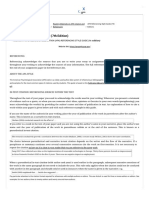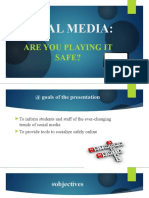Creating An APA Style Reference List Guide: 7th Edition
Uploaded by
Audie Nocedo MontecastroCreating An APA Style Reference List Guide: 7th Edition
Uploaded by
Audie Nocedo Montecastro7th Edition
Creating an APA Style
Reference List Guide
The reference list contains all the Format references in seventh
works you cited in the text of edition APA Style.
your paper. • Double-space the reference list, both within and
between references. Do not add extra lines
• In general, there should be a one-to-one
between references.
correspondence between the works cited in the text
and the works listed in the reference list. • Order references alphabetically, usually by the first
letter of the first author’s last name.
• An exception is personal communications, which are
cited in the text of your paper but are not included • Include the authors’ first and middle initials
in the reference list (see Section 8.9 in the seventh (if they have them). Do not write out first or
edition Publication Manual). middle names.
• If you read a work while doing your literature search • Write author names in inverted format so that the
but did not end up citing it in the text of your paper, last name comes first, followed by a comma and the
do not include it in the reference list. initials. Place a period and a space after
each initial.
Use the section label “References” (not • Apply a hanging indent for all references using
the paragraph-formatting function of your word-
“Works Cited” or “Bibliography”). processing program: The first line is flush left, and all
• Start the reference list on a new page after the text subsequent lines are indented 0.5 in.
of your paper. • APA Style references are organized by group
• Center the label at the top of the page and write it (e.g., textual works, online media), category (e.g.,
in bold. periodical, social media), and type (e.g., journal
article, Facebook post). To create a reference entry,
• It is acceptable to use “Reference” as the label when
first determine the reference group and reference
you cited only one source in your paper.
category, and then choose the appropriate
reference type within the category and follow that
example in Chapter 10 of the Publication Manual.
° Reference formats are based on the document
type (e.g., journal article, report), not the
retrieval method (e.g., online, in print).
° Even if you retrieved a work online, determine
what type of document it is. Only cite a work as a
webpage or website if no other category fits.
Include a DOI or URL at the end Date Element
of the reference for any work that • Most references include only the year as the date.
has one. • Use more specific dates, such as the month, day, and
year (e.g., 2020, June 10), for works published on a
• Most references do not require retrieval dates.
more frequent basis (e.g., newspaper or magazine
Include a retrieval date only when (a) a work is
articles, social media posts). When in doubt,
inherently designed to change over time (e.g., a
check the templates in Chapter 10.
Facebook profile page) and (b) you are citing an
unarchived version of the work, as described in • For webpages and websites, use the date of
Section 9.16 of the Publication Manual. last publication or last update. Do not use the
copyright date from a webpage footer or the date
• Do not include both a DOI and a URL in a reference
of last review. If the date is unknown or cannot be
entry. If a work has both a DOI and a URL, include
determined, write “n.d.” as the date.
only the DOI.
• Copy and paste the DOI or URL directly from your
Title Element
web browser.
• Titles of works that stand alone (e.g., books, reports,
• Do not add a period after the DOI or URL.
webpages) are written in italic sentence case.
• DOIs and URLs can be either blue and underlined
• Titles of works that are part of a greater whole
(usually the default setting for hyperlinks) or plain
(e.g., journal articles, book chapters, dictionary
text that is not underlined. entries) are written in sentence case without italics.
• For book and report references, place any
Avoid the following common mistakes identifying information (e.g., edition, report number,
when writing reference list entries. volume number) in parentheses after the title.
Do not add a period between the title and the
Author Element parenthetical information.
• Use the word “and” between two authors’ names in
narrative in-text citations. Use an ampersand (&)
Source Element
between two authors’ names in parenthetical in-text
citations and before the final author’s name in • In the source element for journal article references:
reference list entries. ° Italicize the journal title and volume number.
° Narrative in-text citation: Sanders and Jang ° Do not italicize the comma between the journal
(2020) found . . . title and volume number, the issue number, and
° Parenthetical in-text citation: A positive page numbers.
association was found . . . (Sanders & Jang, 2020). Place the issue number in parentheses after the
°
° Reference list entry: Sanders, F. A., & Jang, T. D. volume number with no space in between.
(2020).
° Use an en dash (–) to separate a page
• For a work with 21 or more authors, include the first range (e.g., 15–26).
19 authors’ names, insert an ellipsis (. . .), but no • When the author and the publisher of a work are
ampersand, and then write the final author’s name. the same (as in many reports, books, and websites
• For a work with a group author (or multiple group published by group authors), include the group
authors), include a period at the end of the author name in the author element and omit it from the
element in the reference. source element.
° Reference list entry: American Psychological
Association. (2020).
SOURCE: American Psychological Association. (2020).
More information on creating and formatting references and Publication manual of the American Psychological Association
reference lists can be found in Chapter 9 of both the Publication (7th ed.). https://doi.org/10.1037/0000165-000
Manual of the American Psychological Association (7th ed.) and
the Concise Guide to APA Style (7th ed.). CREDIT: TRACI GIULIANO, SOUTHWESTERN UNIVERSITY
You might also like
- American Psychological Association (APA) Referencing Style Guide ReferencingNo ratings yetAmerican Psychological Association (APA) Referencing Style Guide Referencing4 pages
- FYP-Thesis-Referencing GuidelinesFall 2024-FSMNo ratings yetFYP-Thesis-Referencing GuidelinesFall 2024-FSM12 pages
- APA Citation and Referencing 2020 GuideNo ratings yetAPA Citation and Referencing 2020 Guide75 pages
- Example:: APA In-Text Citations Direct QuotesNo ratings yetExample:: APA In-Text Citations Direct Quotes2 pages
- APA Referencing Style Guide (7th Edition) - Reading Materials On APA Citation and Referencing - ENG102 - BIL Courseware - Bux - BRAC UniversityNo ratings yetAPA Referencing Style Guide (7th Edition) - Reading Materials On APA Citation and Referencing - ENG102 - BIL Courseware - Bux - BRAC University16 pages
- American Psychological Association (Apa) Referencing Style GuideNo ratings yetAmerican Psychological Association (Apa) Referencing Style Guide16 pages
- American Psychological Association (Apa) Referencing Style GuideNo ratings yetAmerican Psychological Association (Apa) Referencing Style Guide16 pages
- APA 7 Style Keyano Library Guide - Updated September 14, 2020No ratings yetAPA 7 Style Keyano Library Guide - Updated September 14, 202019 pages
- Apa Documentation Style: A Brief Overview: Creating A Title PageNo ratings yetApa Documentation Style: A Brief Overview: Creating A Title Page18 pages
- Writing Bibliography - in - Text CitationNo ratings yetWriting Bibliography - in - Text Citation32 pages
- Section 07 Citation Styles For ReferencesNo ratings yetSection 07 Citation Styles For References30 pages
- APA_7th_presentation_MJ CCC 9 11 21 (1)No ratings yetAPA_7th_presentation_MJ CCC 9 11 21 (1)46 pages
- American Psychological Association (Apa) Referencing Style GuideNo ratings yetAmerican Psychological Association (Apa) Referencing Style Guide16 pages
- Guide To APA Style Basics: Formatting The Reference List100% (1)Guide To APA Style Basics: Formatting The Reference List2 pages
- APA Citation Style - Cornell University LibraryNo ratings yetAPA Citation Style - Cornell University Library11 pages
- Reporters: Jo-Anne Karen Serdena Toto Taugan Ace GertosNo ratings yetReporters: Jo-Anne Karen Serdena Toto Taugan Ace Gertos29 pages
- Indexes: A Chapter from "The Chicago Manual of Style," Eighteenth EditionFrom EverandIndexes: A Chapter from "The Chicago Manual of Style," Eighteenth EditionNo ratings yet
- Mastering Citation Styles: A Comprehensive Guide to MLA, APA, and Chicago: guide referencesFrom EverandMastering Citation Styles: A Comprehensive Guide to MLA, APA, and Chicago: guide referencesNo ratings yet
- Department of Education: Weekly Home Learning PlanNo ratings yetDepartment of Education: Weekly Home Learning Plan3 pages
- Attendance Sheet: Name Time in Time Out SignatureNo ratings yetAttendance Sheet: Name Time in Time Out Signature18 pages
- Daraga National High School No. of School Days No. of Days No. of DaysNo ratings yetDaraga National High School No. of School Days No. of Days No. of Days7 pages
- Ivi Vassilopoulou-Microsoft® Office Word 2007-Microsoft® Office Word 2007-000230No ratings yetIvi Vassilopoulou-Microsoft® Office Word 2007-Microsoft® Office Word 2007-0002307 pages
- Essay 1 Google Censorship in China Robert SchwienNo ratings yetEssay 1 Google Censorship in China Robert Schwien5 pages
- Nissen 2015 The Weaponization of Social Media.8-57No ratings yetNissen 2015 The Weaponization of Social Media.8-5750 pages
- Sales and Distribution Management: This Photo by Unknown Author Is Licensed Under CC BY-SANo ratings yetSales and Distribution Management: This Photo by Unknown Author Is Licensed Under CC BY-SA17 pages
- Otaku Subculture Character in Japanese Poetry Anthology Otaku SenryuNo ratings yetOtaku Subculture Character in Japanese Poetry Anthology Otaku Senryu9 pages
- Hathway Kolkata A-La-Carte Channel and Price List33% (12)Hathway Kolkata A-La-Carte Channel and Price List1 page
- Nuestro Padre Jesus Nazareno (Lyrics and Chords/Music Sheet)No ratings yetNuestro Padre Jesus Nazareno (Lyrics and Chords/Music Sheet)1 page
- Organic Chemistry - Frederic Stanley Kipping PDFNo ratings yetOrganic Chemistry - Frederic Stanley Kipping PDF281 pages
- The Impact of Technology On Photojournalism - A Prototype For Rethinking Journalism100% (1)The Impact of Technology On Photojournalism - A Prototype For Rethinking Journalism35 pages
- Media Society Technology Industries Content and Users 7th Edition David R. Croteau downloadNo ratings yetMedia Society Technology Industries Content and Users 7th Edition David R. Croteau download53 pages
- Social Media:: Are You Playing It Safe?No ratings yetSocial Media:: Are You Playing It Safe?19 pages
- Codes and Conventions of Indie Rock MusicNo ratings yetCodes and Conventions of Indie Rock Music3 pages
- 5 Rock Progressivo Italiano: - 120 Rating S Studio, 2014No ratings yet5 Rock Progressivo Italiano: - 120 Rating S Studio, 201420 pages
- The Standard Definition of Creativity: Creativity Research Journal January 2012No ratings yetThe Standard Definition of Creativity: Creativity Research Journal January 20127 pages
- NCR-MLA-MediaInfoLit-M3 Edited Layson Dimaano Writer IguasNo ratings yetNCR-MLA-MediaInfoLit-M3 Edited Layson Dimaano Writer Iguas18 pages






































































































